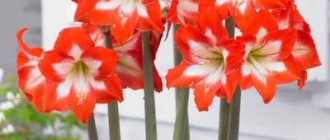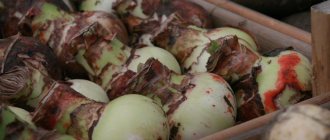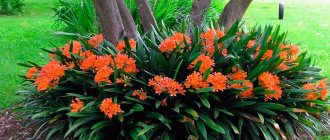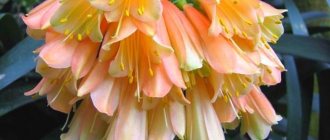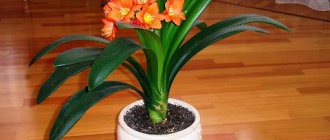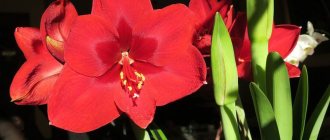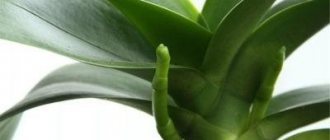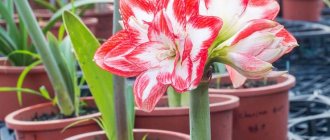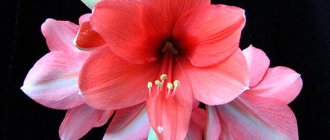Origin and appearance of clivia
Clivia belongs to the perennials from the Amaryllis family. The plant is herbaceous, numbering 5 species in the genus. Homeland - South Africa, habitat - tropical forests, shady foothills and coasts.
Clivia's habitat is tropical forests
Clivia became famous in the 19th century, and it was named after the Duchess of Northumberland, Charlotte Clive.
Clivia reaches a height of 60 cm and has no stem. The leaves are leathery and broadly belt-shaped, growing from the root. They tightly embrace each other, creating something like a stem. The flowers, in their shape, resemble a bell or a gramophone, are collected in a thick, multi-flowered umbrella, numbering up to 60 flowers. Colored in yellow-pink, orange and red-orange. The rhizome is short, with fleshy, slightly fibrous roots. Serves to accumulate moisture and nutrients.
Clivia is self-pollinating. The process of ripening fruits and seeds lasts up to 10 months and takes a lot of energy from the plant.
Clivia seeds ripen within 10 months
Clivia is a long-lived flower. With proper care, this beauty can live up to 40 years.
How is clivia different from valotta?
Valotta looks similar to clivia
These two plants are similar - it is very difficult to distinguish them. But if you look closely, you will immediately find characteristic features:
- The root of valotta is a bulb, while that of clivia is a rhizome.
- The leaves are different. In Valotta they are narrower, reddening at the base, growing not from the rhizome, but singly, filling the pot.
- The inflorescence of Valotta is not as multi-flowered as that of Clivia. But the flowers themselves are larger.
- Valotta produces numerous babies, which often grow on the surface of the soil.
- If you accidentally damage a clivia leaf, bright orange juice will appear on it.
Fans of indoor floriculture love clivia for its unpretentiousness and beauty. The plant can easily be used both as an ornamental foliage plant and as a flowering one. And even the most inexperienced gardeners can handle the new varieties that have appeared and are suitable for growing in an ordinary apartment.
Flower growers fell in love with clivia for its beauty and unpretentiousness.
Types and varieties of clivia
As already mentioned, there are five types of clivia:
- Clivia Gardena. Named after Major Robert Garden, who discovered this species. The plant grows up to 50 cm in height. The leaf shape is xiphoid, up to 50 cm long and 4 cm wide. The leaf blades are painted bright green. The peduncle is up to 45 cm, it contains about 16 flowers, which have a narrow tubular shape and are colored in shades of red and orange.
- Clivia stem. The only species in which a trunk up to two meters high is formed from dried lower leaves. The leaves reach a length of up to 100 cm, are dark green in color and have a belt-like shape. Sometimes it produces several flower stalks. Each can have up to 20 drooping, bell-shaped, orange-red flowers. The tips of the petals are painted soft green.
- Clivia is wonderful. Miniature appearance, only up to 30 cm in height. The leaves are sword-shaped with a sharp edge, dark green. The long peduncle can contain up to 60 tubular-shaped flowers. The color is orange with a bright yellow center.
- Clivia cinnabar, or orange (miniata). Herbaceous perennial with dark green, belt-shaped leaf blades. Their length is 60 cm and width is 6 cm. The leaves are collected in a rosette. The plant reaches 50 cm in height. The length of the peduncle is 45–50 cm. The umbellate inflorescence contains about 20 flowers, shaped like a wide funnel and colored yellow-orange, sometimes with a yellow spot at the base. Once fully opened, they form a stunningly beautiful flower ball.
- Clivia is amazing. This plant really amazed and surprised botanists, since the climatic conditions of its habitat are sharply different from those in which other types of clivia grow. The view was opened only recently, but is already popular.
Types of clivia in the photo
Clivia is amazing
Clivia Gardena
Clivia is beautiful
Clivia stem
Clivia cinnabar
In addition, there are many varieties and varieties of this stunning flower.
Variety of clivia varieties - photo gallery
The Midas variety has lemon-yellow flowers.
Variety cyrtanthiflora “Porcelain” – a hybrid of clivia vernacular and noble clivia
Mark's Pink variety has orange flowers
Summer Surprise flowers have a delicate salmon hue
Sir John Thuron Yellow – large-flowered variety, yellow color
The Japanese pastels variety is painted in calm and soft pastel colors
It should be remembered that clivia is a poisonous plant; it contains the alkaloid lycorine. It can cause not only indigestion, but also nausea and vomiting. Large doses can lead to paralysis. In families with small children or pets, clivia must be placed in places inaccessible to them.
Clivia is a very beautiful plant, but you should remember that it is poisonous
Virulence
Despite its beautiful appearance, in which the bright flowers of clivia attract attention, it is a poisonous plant. First of all, it is necessary to keep the plant where children and animals cannot reach it, because ingesting a very small amount of juice from clivia leaves can cause:
- vomiting;
- diarrhea;
- abdominal pain of varying degrees;
- sometimes even paralysis.
Needless to say what can happen if a child or animal eats a whole leaf or flower or even a small part of it.
Conditions for seasonal maintenance of clivia - table
| Season | Temperature | Humidity | Lighting | Location |
| Spring | During the growing season, keep the temperature within +20...+26 °C. At +28 °C the leaves may dry out and growth slows down. | Clivia does not need high humidity. It is enough to maintain a level of 45–50%. On very hot days, you need to wipe the foliage with a damp cloth, removing dust, and sometimes spray it. | For clivia, bright but diffused light is preferred. It is better to hide it from the sun's rays behind a light curtain. Do not place clivia in a darkened room - this will negatively affect flowering. | It is ideal to place clivia on a western or eastern window, shading from 11 a.m. to 5 p.m. During the summer months, you can move the plant to the balcony or garden, finding a place protected from drafts and bright sunlight. |
| Summer | ||||
| Autumn | The optimal temperature for this period is from +10 °C to +15 °C. | From the end of autumn, move the pot with the plant to a south window, shading it from the midday sun. | ||
| Winter |
Clivia will do well outdoors during the summer months.
The room in which clivia grows should be ventilated periodically. On a north window, due to lack of light, it will be difficult to achieve clivia flowering. On a south window in the summer, the leaves of the plant will suffer from burns.
Beneficial features
According to many beliefs and signs, clivia is a plant that can help in learning sciences, improving concentration and increasing brain performance. Finding this plant in the house will help awaken a person’s curiosity and desire to gain new knowledge.
also helps to harmonize a person’s emotional state: he becomes softer and kinder, less likely to show negative emotions (for example, extreme irritability or vulnerability).
This plant can become a kind of shield against bad mood, saving in moments of emptiness and weakness. Clivia has a beneficial effect on health: it keeps the heart in good shape and maintains a vigorous state of the body as a whole.
What you need to know about planting and transplanting
When preparing to plant clivia, take care when choosing a pot. It should be high and deep, with drainage holes. This is due to the fact that the plant has powerful roots growing deep into the soil. It is better to buy a ceramic pot, it is more stable, slightly larger in size than the previous one - the difference should be literally a couple of centimeters. In a cramped pot, clivia feels much more comfortable and blooms more readily.
A tall pot is suitable for planting clivia.
The soil is suitable: loose, light, well-permeable to moisture and air, slightly acidic - with a pH of about 6. Most often, gardeners use this mixture for planting:
- Turf soil - 2 parts.
- Leaf humus - 1 part.
- Peat - 1 part.
- Perlite or coarse sand can be added as a leavening agent, and charcoal acts as an antiseptic.
Only young clivias are replanted annually. It is better not to touch adult plants for 2–3 years. They need to be replanted only if the roots have grown through the drainage hole or the plant is sick.
Only young plants should be replanted annually
The transplantation process begins only after the clivia blooms.
Step by step process
- Pour a layer of drainage into the new pot so that it completely covers the bottom. Then add soil substrate.
- Carefully release the plant from the old pot. There is no need to forcefully shake off the soil. Your task is not to harm the fragile roots. Injured roots can cause the death of the plant. Immediately sprinkle the damage with crushed coal or ash.
- Transfer the clivia into the prepared pot, adding the remaining wet soil to the sides.
- Try not to bury the root collar.
- After transplantation, do not water the clivia for several days; you can only lightly spray the top layer of the substrate. The wounds on the roots will heal during this time.
- Then continue the watering process as usual.
Clivia is transplanted using the transshipment method
After replanting, try to place the plant exactly as it was before. You should not turn the clivia every now and then with different sides to the light source.
Introduction
As such, the concept of “bulbous” does not exist in botany. This word unites several dozen genera of plants cultivated by humans, mainly for decorative purposes, having a modified stem - a bulb. This is not a root tuber, like potatoes, and not a nodule, like legumes, used exclusively as storage of nutrients. The bulb is not just a repository of “building material”, it is like a miniature plant embryo.
Three types of bulbous plants in a flowerbed
The presence of a bulb is most often characteristic of three families: Liliaceae, Amaryllis and Alliumceae. The first include the well-known lilies and tulips, the second - daffodils, irises and snowdrops, and the third - the various onions and garlics known to everyone. Recently, it has been believed that Alliums are a subfamily of Amaryllis, but gardeners, as a rule, do not go that deep into botany.
Most primroses are bulbous. Scilla or Scylla
The popularity of bulbous plants is explained by several important circumstances. Firstly, it is possible to constantly replant them with each new season. Since the plant enters a dormant period in winter, its bulb can be easily dug up and replanted without any fear of damage to the root system.
The second important condition that ensures the popularity of bulbs is the ability to adjust the time of their growth and flowering within a very wide range (almost all year). This process is called forcing; it is very convenient for obtaining flowers of certain plants by a certain date.
The third advantage of bulbous plants is their excellent ability for vegetative propagation, which allows them to obtain good quality seed material for several years in a row at no particular cost. As a rule, the degeneration of bulbous plants with exclusively vegetative propagation is about 5 to 10 years, which gives a fairly large margin of time when planning their replacement with other crops.
Bulbous in natural environment. Crocuses
Naturally, like any phenomenon, the use of bulbous plants has its drawbacks, which mainly come down to excessive depletion or even poisoning of the soils in which they are grown without crop rotation for several years.
Currently, there are a huge number of these plants that can decorate both any garden and the interior of any home due to the variety of their colors and shapes. The agricultural technology of most bulbous plants is quite simple. Growing them does not require any special skills or even technical means.
The greatest labor intensity when working with these plants is the work of replanting them or storing some heat-loving species in the winter. Other activities related to them practically do not require the gardener’s attention.
Most bulbous plants are of tropical or subtropical origin. Despite this, many plants in our climate thrive in open ground. They endure cold winters in a dormant state, sometimes withstanding frosts down to -30°C. Some species (crocuses, snowdrops) can tolerate temperatures down to -10...12°C during the active growing season. Let's look at the most popular types of bulbous plants.
Projects of country houses for 6-10 acres: 120 photos, description and requirements | The most interesting ideas
Plant care
Watering
The plant needs to be watered well, but not often. The rule is that it is better to underfill than to overfill; this is perfect for a flower. The next watering is carried out when the top layer of soil dries out - approximately once every 4-5 days. Make sure that the root collar does not get wet. Always drain the moisture from the pan. Water with warm, settled water.
Clivia root is able to accumulate moisture - this helps the plant easily tolerate drought.
With the onset of autumn, when the temperature begins to drop, the amount of watering is reduced. This helps the plant prepare for the dormant period. In winter they stop watering. But there are exceptions - if the clivia begins to shed its leaves, then it can be slightly moistened.
Top dressing
The ideal fertilizing option would be to alternate mineral fertilizers with organic ones. Nitrogen included in fertilizing has a positive effect on the growth of leaf mass, but reduces the flowering period. The frequency of feeding is 2 times a month.
For fertilizing, you need to choose fertilizers for flowering or bulbous plants, diluting them a little more than indicated on the package. Apply fertilizer only in liquid form after watering.
In winter, clivia is not fertilized.
Clivia is responsive to the application of fertilizers, but you should not abuse them
Rest period
This period is very important for the formation of a flower bud and further flowering. In young plants, the dormant period is shorter and lasts about two months, while adult plants will need more time to regain strength - at least 3 months. This important stage begins in October. Reducing the frequency of watering helps the plant smoothly transition to rest. During dormancy, fertilizing and watering stop; you can only occasionally moisten the surface of the earth with a spray bottle so that the leaves do not begin to dry out. The temperature in the room with clivia should be maintained at +10 °C…+12 °C.
Keeping clivia in a cold room for too long can slow down the growth of the peduncle. In this case, water the flower with water heated to +40 °C. This will help the plant come out of dormancy and stimulate the peduncle, causing it to develop normally.
Young plants that have not reached the age of three years are not sent to rest.
The rest period for clivia is the key to rapid flowering
Bloom
As a rule, clivia blooms in February, after the end of the dormant period. The buds open gradually, so you can admire the beautiful sight for almost a month.
As soon as a peduncle appears, the length of which will be at least 10–15 cm, move the clivia to a warm room. Start fertilizing and watering. The main thing is not to overdo it, the whole process follows the usual pattern.
An adult clivia can delight you with repeated flowering in the summer. In order to admire the wonderful flowers, create an artificial dormancy period for the plant in mid-summer. Move the pot to a cool, slightly dark place. Reduce watering and stop fertilizing altogether. After about 2 weeks, the lower leaves of the clivia will begin to turn yellow, but at the same time a new peduncle will appear.
After the peduncle fades, do not rush to remove it immediately. Let it dry completely, and then carefully unscrew it from the sheet socket. But if you decide to wait until the fruits and seeds ripen, leave the peduncle, water and fertilize the plant regularly. There will be no repeat flowering this year.
An adult clivia can delight you with flowering 2 times a year.
Errors in care and their elimination - table
| Problem | Cause | Elimination |
| Clivia doesn't want to bloom |
|
|
| The peduncle is too short during the active growing season |
|
|
| Leaves lose color, flower stalks do not form | Lack of nutrients. | Adjust plant nutrition. |
| Light spots appear on the leaves | Sunburn. This problem is relevant for a plant standing on a south window. | Shade the plant. |
| The tips of the leaves become brown, the base of the stem and roots rot | Overmoistening of the soil. |
|
| During the growth period, the leaves began to turn yellow and die. |
|
|
Underdevelopment of the clivia peduncle is possible due to prolonged exposure to low temperatures on the plant.
Diseases and pests, control measures and prevention - table
| Diseases and pests | Symptoms | Control measures | Prevention |
| Stagonosporosis, or red burn | Red spots appear on the leaves and peduncles, and the damaged parts become soft. With severe damage, the leaves are deformed, the flower stalks are bent, and the intensity of flowering decreases. |
|
|
| Shchitovka | The plant is covered with brown tubercles. Young pests very quickly spread throughout the plant, feeding on its sap, weakening the clivia. | Treatment is carried out with the help of Actellik. The solution should be prepared strictly according to the standards indicated on the label. Processing should be carried out outdoors, using protective equipment - gauze bandage, gloves. |
|
| Mealybug | The leaves become deformed, dry out and fall off. White discharge, similar to pieces of cotton wool, appears on the affected parts of the clivia. Severely damaged flowers seem to be covered with fluff. | ||
| Aphid | The pest settles on the underside of the leaf. It feeds on the sap of the plant, injects poison into it, which greatly depletes the flower, making it defenseless against fungal diseases. |
Threats to clivia in the photo
Aphids significantly weaken clivia. Plants severely affected by mealybugs seem to be covered with fluff.
Scale insect larvae can spread throughout the plant very quickly
The appearance of stagonosporosis is promoted by constant waterlogging of the soil.
Hippeastrum
(Hippeastrum - cavalry star) grow in the llanos of Venezuela. Llanos are flat, dusty, dull steppes with their monotony, burning out in the summer. They, just like the Karoo Desert, come to life during the spring rains, becoming covered with flowering bulbous and other herbaceous plants. Brazilian hippeastrums, growing on desert plateaus, have flowers that are red on the outside and white on the inside. There is a species with carmine flowers, shimmering with velvet. Only a special type of Virginia hippeastrum grows in the shady and damp forests of southern North America. Their flowers vary in color: first purple, they turn pink and then white.
Various species of hippeastrum crossed with African amaryllis have produced a large variety of hybrid varieties.
Rice. Clivia
Hybrid amaryllis have two or three large flowers on the flower arrow, and their varieties have poetic names: “Melody”, “Mikaela”, “Salambo”, “Chloe”, “Puccini” and others.
The large stamens and pistil are very clearly visible on the flower. When cut, the internal structure of the anthers at the ovary is also clearly visible.
By placing amaryllis pollen in a drop of a fifteen percent sugar solution, you can see its germination through a magnifying glass within an hour.
If the pistil is pollinated with pollen, the ovary grows into a large capsule with flat seeds with thin black wings. The seeds lie in a box in high packs. Small plants grow from the seeds, which bloom only in the third year, when a large (up to twenty centimeters in circumference) bulb is formed. The bulbs also produce bulbs - “babies”, which bloom in the second year. With patience, you can grow a large number of amaryllis.
In Adler, on the state farm "Southern Cultures", they began to grow amaryllis in 1936, having 150 bulbs and two bags of seeds. By 1941, 34 thousand bulbs were already blooming on the plantations.
In the summer, after the leaves dry out, place the bulb in a dark, cool (at least 10°C) place and stop watering.
Rice. Krinum
In November, they begin to lightly water it with warm water and place it on the window.
First, in order for the flower arrow to grow above the leaves, the bulb is shaded with a paper cap until the arrow appears above the leaves. Amaryllis should not be watered frequently before flowering.
Hybrid amaryllis blooms in February - March. Amaryllis are replanted after three years, immersing the bulb one-third in greenhouse soil mixed with rotted foliage, with an admixture of coarse sand and crushed charcoal.
Reproduction
At home, clivia is easily propagated in two ways: vegetatively - by division during transplantation, and generatively - by germinated seeds.
Division
Division is the easiest and most popular way to propagate clivia. But it should be carried out only during a planned transplant after flowering, since the plant really does not like interference. For separation, lateral shoots that have grown at least 10 cm from the soil surface and have 4 leaves are suitable.
- Prepare small pots, 7 cm in diameter, and fill them halfway with sand or a mixture of sand and leaf soil.
- Carefully separate the babies from the mother plant, being careful not to damage the roots. If this happens, immediately sprinkle the wounds with activated carbon.
- Place the separated plants in pots and add sand mixture.
- Lightly moisten the soil and place the clivia in a bright place with a temperature of +18 °C.
- After rooting, the young plants are transplanted into slightly larger pots with a suitable earthen mixture. Clivias will bloom in 2–3 years.
Dividing clivia during transplantation is an easy way to propagate the plant.
Planting seeds
This method is not as popular as the first. Seeds can be bought in a store or collected yourself by artificially pollinating a flowering clivia. In this case, you need to wait until the fruits are fully ripened. When they are completely soft, it is time to collect the seeds. The right time to germinate them is from October to April.
The seeds are laid out on a substrate consisting of equal parts sand and turf soil, half part peat. The distance between the seeds should be approximately 2 cm. The container is covered with a cellophane bag, creating greenhouse conditions. The humidity inside should be sufficient, but not excessive. Temperature about +25 °C.
The distance between clivia seeds when planting should be at least two centimeters
Expect seedlings to appear in about 5 weeks. Seedlings can be planted as soon as they have one leaf.
A clivia seedling, ready to be transplanted into a separate pot, looks like this
Flowering feature
Clivia blooms annually, from the second year of life, usually in February or March. But as it gets older, it begins to bloom more often, up to 2 times a year.
First, in the middle of the rosette of leaves, an arrow-peduncle, 20-40 cm long, is formed. At its top there is a large inflorescence, up to 20 cm in diameter, consisting of many buds. Each opened bud in the form of a tubular bell consists of 6 delicate petals. The flowers bloom gradually, which is why flowering can last about a month.
Hemanthus
An evergreen ornamental plant belonging to the amaryllis family. The plant is found in the wild exclusively in South Africa; it does not grow “wild” anywhere else in the world (see photo).
It is popularly called “elephant tongue” for its rough and very wide leaves. In indoor floriculture, two hybrid varieties are usually used:
- hemanthus Katarina;
- white-flowered.
The second species blooms in a very unique way: together with its petals there is a cluster of snow-white stamens with yellow tips.
Hemanthus Catarina has red flowers. Translated, the name of the plant means “bloody flower,” which is quite consistent with its bright red, richly hued petals. But the white-flowered version is more popular in indoor floriculture. The flowering period of hemanthus is late summer-early autumn.
Both species are easy to care for; watering is required moderately, and during the dormant period, even infrequently. The foliage remains green and decorative all year round. This plant does not grow tall; usually the height of the hemanthus does not exceed 40 cm.
Hemanthus cannot be kept in direct sunlight - its leaves can burn and dry out at the tips. Therefore, on the southern window sill, shade the window with paper or light cloth. Complex formulations for bulbous plants are suitable as feeding; during the growing season, hemanthus is fed two to three times. In winter, a period of rest is needed with maintenance at a temperature of +15-18 degrees.
Hippeastrum
There are several dozen types of hippeastrum, each of which has its own characteristics. Some species are confused with Amaralis, but the shape of their bulbs is different; in Hippeastrum they are more rounded.
Hippeastrum Leopolda has huge flowers, scarlet in the center, white on the outside, which bloom in the fall. Spotted hippeastrum, which blooms in late winter to early spring, has claw-shaped, creamy petals covered in red spots. There are varieties of this houseplant that have striped flowers, as well as lemon yellow ones.
It is important to know that if hippeastrum is not given a period of rest, it will not bloom.
Bulbous primroses
The flowering season opens with Scilla, which has about two dozen species and delights the eye with all shades of blue and lilac-lilac.
Erantis (spring flower) - its bright yellow flowers bloom in March, without waiting for the snow to melt. For greater decorativeness, spring flower bulbs should be planted in groups.
Next, Puschkinia blooms with delicate white and pale blue flowers.
Only after getting out from under the snow does it reveal its spectacular star-flowers of lilac-lilac and deep pink chionodox. This plant is recommended to be used for decorating alpine slides and rockeries.
Kandyk or erythronium (Erythronium) is an elegant bulbous perennial, described by the ancient Greek scientist Dioscorides. This striking representative of the lily family prefers to decorate shaded areas and northern facades of buildings.
Muscari (Muscari) grows in a dense carpet of blue, light blue, white and pink inflorescences. Muscari or mouse hyacinth goes well with other bulbous plants.
The eastern hyacinth (Hyacinthus orientalis) is called the king of bulbous plants. A universal flower with a strong aroma, suitable for cutting, forcing, and growing in open ground. Tulips are favorites of landscape designers; like all ephemerals, they have adapted to life in almost any climatic conditions. They are represented by a large number of varieties (about 1800) of various shapes - lily, fringed, peony, terry, etc.
Hemanthus
houseplant411.com Hemanthus is an unpretentious bulbous flower that adapts well to indoor conditions.
Its leaves are dark green and dense, their length reaches 20–25 cm, width - 8–10 cm. Because of their shape, the plant is sometimes called “deer tongue”. Hemanthus blooms in late summer or autumn. The height of the peduncles usually does not exceed 25 cm. The inflorescences of the plant look like fluffy balls. The most popular indoor species, the white-flowered hemanthus, has milky white flowers, while the Katerina hemanthus has deep red ones.
Where to put
In a well-lit place. The plant must be protected from direct sun, otherwise unsightly burn spots will appear on the leaves, and over time they will die off altogether. From spring to autumn, hemanthus feels normal at normal room temperature. And in winter it needs coolness - from 12 to 15 ° C.
How to water
Moderately, the soil in the pot should have time to dry out by about half. Hemanthus does not tolerate stagnation of moisture in the soil and its waterlogging, so it is not worth flooding. High humidity and spraying are not needed.
Hemanthus
houseplant411.com Hemanthus is an unpretentious bulbous flower that adapts well to indoor conditions. Its leaves are dark green and dense, their length reaches 20–25 cm, width - 8–10 cm. Because of their shape, the plant is sometimes called “deer tongue”.
Hemanthus blooms in late summer or autumn. The height of the peduncles usually does not exceed 25 cm. The inflorescences of the plant look like fluffy balls. The most popular indoor species, the white-flowered hemanthus, has milky white flowers, while the Katerina hemanthus has deep red ones.
Where to put
In a well-lit place. The plant must be protected from direct sun, otherwise unsightly burn spots will appear on the leaves, and over time they will die off altogether. From spring to autumn, hemanthus feels normal at normal room temperature. And in winter it needs coolness - from 12 to 15 ° C.
How to water
Moderately, the soil in the pot should have time to dry out by about half. Hemanthus does not tolerate stagnation of moisture in the soil and its waterlogging, so it is not worth flooding. High humidity and spraying are not needed.
Hippeastrum
Hippeastrum is an indoor bulbous plant with beautiful large flowers, the diameter of which can reach 20 cm. It usually blooms in late winter or spring. At this time, 1–2 arrows with 4–6 buds appear on each bulb.
Breeders have developed many varieties of various colors: with red, orange, white-pink and other bright inflorescences, sometimes decorated with stripes or other “patterns”.
Where to put
On the southeast, east, south or southwest window, so that the plant has enough light and warmth. The temperature from spring to autumn should be room temperature, but during the rest period it should be approximately 10–12 °C.
How to water
Regularly during the period of active growth and flowering, and it is advisable to do this through a tray. Do not overwater: hippeastrum tolerates slight drying out more easily than a swamp in a pot. From the end of September or the beginning of October, it is necessary to gradually increase the intervals between waterings. By the beginning of winter, a period of rest begins, which lasts a couple of months. During cool wintering in a dark place, watering is not necessary.
